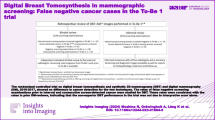Abstract
Objectives
To evaluate tomosynthesis compared with 2D-mammography in cancer detection and recalls in a screening-programme, and assess performing synthesized instead of 2D, and compare double reading of 2D with single reading of tomosynthesis.
Methods
Women (age 50–69 years) participating in the screening-programme were included. 2D-mammography and tomosynthesis were performed. There were four reading models: 2D-mammography (first); 2D-mammography (second); tomosynthesis + synthesized (third); tomosynthesis + synthesized + 2D (fourth reading). Paired double reading of 2D (first+second) and tomosynthesis (third+fourth) were analysed.
Results
In 16,067 participants, there were 98 cancers and 1,196 recalls. Comparing double reading of 2D with single reading of tomosynthesis, there was an increase of 12.6 % in cancer detection with the third reading (p= 0.043) and 6.9 % with the fourth reading (p=0.210), and a decrease in recalls of 40.5 % (p<0.001) and 44.4 % (p<0.001), respectively. With double reading of both techniques, there was an increase in cancer detection of 17.4 % (p = 0.004) and a decrease in recalls of 12.5 % (p = 0.001) with tomosynthesis.
Conclusion
Single reading of tomosynthesis plus synthesized increased cancer detection and decreased recalls compared with double reading 2D. 2D did not improve results when added to tomosynthesis.
Key Points
• Tomosynthesis increases cancer detection and decreases recall rates versus 2D mammography.
• Synthesized-mammography avoids performing 2D, showing higher cancer detection.
• Single reading of tomosynthesis + synthesized is feasible as a new practice.

Similar content being viewed by others
Abbreviations
- DCIS:
-
Ductal carcinoma in situ
- IDC:
-
Invasive ductal carcinoma
- ILC:
-
Invasive lobular carcinoma
- MGD:
-
Mean glandular dose
- PPV:
-
Positive predictive value
References
Acebal M, Álvarez M, Bayo E et al (2011). Proceso Asistencial Integrado. Cáncer de mama. Detección precoz de cáncer de mama. 3rd edn. Junta de Andalucía. Consejería de Salud
Coldithz G, Bohlke K (2014) Priorities for the Primary Prevention of Breast Cancer. CA Cancer J Clin 64:186–194
Rodríguez M, Osa AM (2013) Breast cancer screening: current status. Radiologia 55:305–314
Conant E (2014) Clinical implementation of digital breast tomosynthesis. Radiol Clin N Am 52:499–518
Houssami N (2013) Digital breast tomosynthesis: the future of mammography screening or much ado about nothing? Expert Rev Med Devices 10:583–585
Rafferty E, Park J, Philpotts LE et al (2014) Diagnostic Accuracy and recall rates for digital mammography and digital mammography combined with one-view and two-view tomosynthesis: results of an enriched reader study. AJR Am J Roentgenol 202:273–281
Lang K, Andersson I, Rosso A, Tingberg A, Timberg P, Zackrisson S (2016) Performance of one-view breast tomosynthesis as a stand-alone breast cancer screening modality: results from the Malmö Breast Tomosynthesis Screening Trial, a population-based study. Eur Radiol 26:184–190
Skaane P, Bandos A, Gullen R et al (2013) Prospective trial comparing full-field digital mammography (FFDM) versus combined FFDM and tomosynthesis in a population-based screening programme using independent double reading with arbitration. Eur Radiol 23:2061–2071
Feng S, Sechopoulos I (2012) Clinical Digital Breast Tomosynthesis System: Dosimetric Characterization. Radiology 263:35–42
Bernardi D, Macaskill P, Pellegrini M et al (2016) Breast cancer screening with tomosynthesis (3D mammography) with acquired or synthetic 2D mammography compared with 2D mammography alone (STORM-2): a population-based prospective study. Lancet Oncol 17:1105–1113
Houssami N, Macaskill P, Bernardi D et al (2014) Breast screening using 2D-mammography or integrating digital breast tomosynthesis (3D-mammography) for single-reading or double-reading. Evidence to guide future screening strategies. Eur J Cancer 50:1799–1807
D’Orsi CJ, Sickles EA, Mendelson EB et al (2013) ACR BI-RADS Atlas, breast imaging reporting and data system, 5th edn. Am Coll Radiol, Reston
Skaane P, Bando A, Gullien R et al (2013) Comparison of digital mammography alone and digital mammography plus tomosynthesis in a population-based screening program. Radiology 267:47–56
Gilbert F, Tucker L, Gillan M et al (2015) The TOMMY trial: a comparison of TOMosynthesis with digital MammographY in the UK NHS Breast Screening Programme – a multicentre retrospective reading study comparing the diagnostic performance of digital breast tomosynthesis and digital mammography with digital mammography alone. Health Technol Assess. https://doi.org/10.3310/hta19040
Ciatto S, Houssami N, Bernardi D et al (2013) Integration of 3D digital mammography with tomosynthesis for population breast-cancer screening (STORM): a prospective comparison study. Lancet Oncol 14:583–589
Skaane P, Bandos A, Eben E et al (2014) Two-view digital breast tomosynthesis screening with synthetically reconstructed projection images: comparison with digital breast tomosynthesis with full-field digital mammographic images. Radiolgy 271:655–663
McCarthy A, Kontos D, Synnestvedt M et al (2014) Screening outcomes following implementation of Digital Breast Tomosynthesis in a General-Population Screening Program. J Natl Cancer Inst. https://doi.org/10.1093/jnci/dju316
Acknowledgements
The data manager who performed the data collection was Cristina Amate Rivas.
Funding
This study has received funding by SERAM (Sociedad Española de Radiología Médica).
Author information
Authors and Affiliations
Corresponding author
Ethics declarations
Guarantor
The scientific guarantor of this publication is Sara Romero Martín.
Conflict of interest
The authors of this manuscript declare relationships with the following companies: Hologic (Bedford, MA, USA) sponsored the study by providing the breast tomosynthesis equipment.
Statistics and biometry
Dra. Pilar Font Ugarte kindly provided statistical advice for this manuscript.
Informed consent
Written informed consent was obtained from all subjects (patients) in this study.
Ethical approval
Institutional Review Board approval was obtained.
Methodology
• prospective
• observational
• performed at one institution
Rights and permissions
About this article
Cite this article
Romero Martín, S., Raya Povedano, J.L., Cara García, M. et al. Prospective study aiming to compare 2D mammography and tomosynthesis + synthesized mammography in terms of cancer detection and recall. From double reading of 2D mammography to single reading of tomosynthesis. Eur Radiol 28, 2484–2491 (2018). https://doi.org/10.1007/s00330-017-5219-8
Received:
Revised:
Accepted:
Published:
Issue Date:
DOI: https://doi.org/10.1007/s00330-017-5219-8




